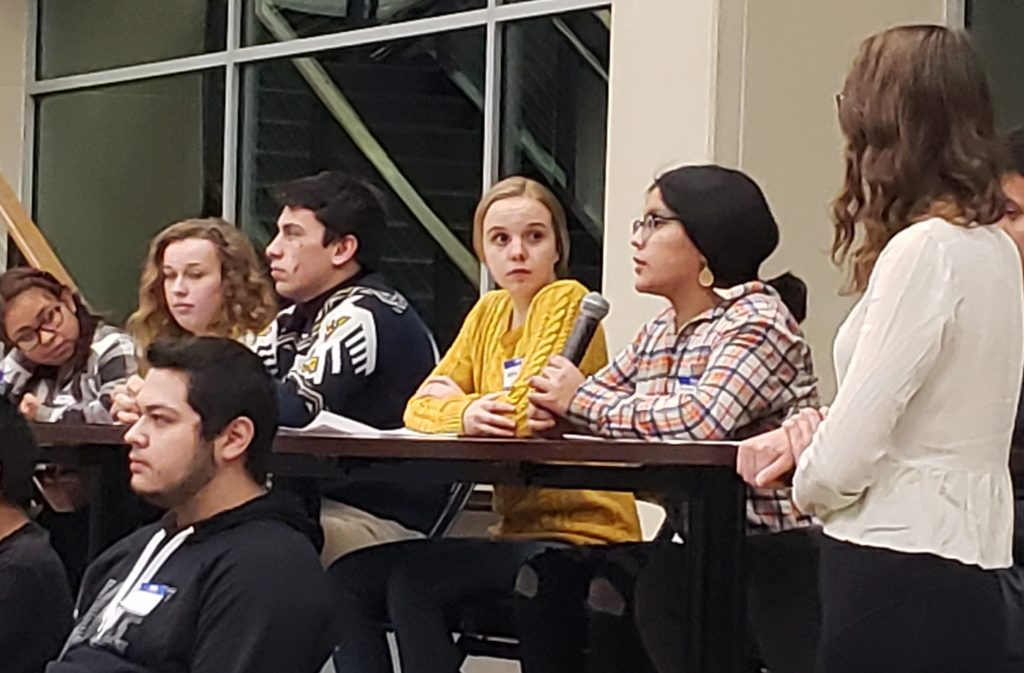How Should Schools Approach Diversity?
The politics of race and equity in education has caused backlash locally and around the country.

Baraboo High School students took part in a panel discussion on diversity at Baraboo High School in December 2019. Photo by Erik Gunn/Wisconsin Examiner.
Throughout Black History month in February, Black Lives Matter signs went up in some schools while the same signs in other schools were being torn down.
National, state and local-level battles over Critical Race Theory, which erupted at the same time parents were getting charged up about mask-wearing and other pandemic protocols in schools, have energized conservatives and played a role in school board races and school governance. But as pandemic restrictions relax, it’s unclear how much diversity training and Black Lives Matter signs will remain an energizing force in the next round of school board races in April.
Black Lives Matter at School is a national coalition organizing for racial justice organized by the National Education Association (NEA). School districts around the country participated in the National Black Lives Matter Week of Action this year, Jan. 31 – Feb. 4. Milwaukee Public Schools was the only Wisconsin school system to officially participate this year although other school districts may have pulled elements from the BLM at School website.
In Milwaukee, on Monday, Jan. 31, the week kicked off with a presentation by Decoteau Irby, Ph.D., associate professor of educational policy studies at the University of Illinois – Chicago and author of Stuck Improving: Racial Equity and School Leadership where he outlines how schools can move from being “stuck” in failure to embrace an improvement process.
Milwaukee school superintendent Keith Posley found many aspects of the action week powerful.
He observed how intensely high school students absorbed the movie, John Lewis: Good Trouble.
An intergenerational panel discussion was important, he said, because so many young people spend so little time with elders in the community, hearing what it was like growing up Black in years past.
Pushback
“NEA Demands: Justice For Black Lives” states NEA EdJustice, the sponsor of Black Lives Matter at School. It makes four “demands” under the following headings:
- Transforming Policing Policies for Safe and Just Communities
- Healthy Communities and Schools
- Empowering Communities and Schools
- Ensuring the Right to Vote for Black, Brown, Native and AAPI Voters
At its national website, Black Lives Matter at School makes no apology for its goals: “[to] mobilize activists in the fight for racial, social and economic justice in public education… and offer resources and tools for activism.”
“Lawmakers in at least 27 states are attempting to pass legislation that would require teachers to lie to students about the role of racism, sexism, heterosexism, and oppression throughout U.S. history,” the NEA EdJustice website states. “In response, educators across the United States are signing a pledge to teach truth.”
An opponent of this approach, Conor Friederdorf, writes in a March 14, 2021 article in The Atlantic headlined “What Happens When a Slogan Becomes the Curriculum” that BLM at School has moved from giving information about America’s history of racism to pure indoctrination.
But supporters of BLM at School contend that students are already being indoctrinated on the other side to accept or at least tolerate elements of racism or deny that systemic racism exists in our society. There are not always two sides to every conflict, they say Sometimes one side is right; the other side is wrong.
In February 2018, in Oconomowoc, the high school principal and one school board member resigned after the high school was told to curtail any discussion of “white privilege.” In August 2021, three more Oconomowoc school board members resigned stating that conflicts with other board members and an interim superintendent made continuing on the board counterproductive.
“CRT isn’t here? Are you sure about that? It’s in Oconomowoc, it’s in Beloit, it’s in Elmbrook,” school board candidate Alexandra Schweitzer wrote on her campaign Facebook page. “It’s everywhere. Parents need to rise up and get this vile hate out of OUR schools! We need to remind the school boards that these are OUR kids. And the board serves US! We, the People [do]NOT give consent for this garbage to be indoctrinated into our kids minds!”
Schweitzer lost her election but got more votes than incumbent Juliet Steitzer who also lost her seat on the board. Steitzer was one of three board members who faced a recall effort in September 2020, but the recall petition failed to garner enough signatures. The main issue highlighted in the recall effort was not critical race theory or white privilege but in-person learning versus virtual and hybrid.
The mixing of racial issues and pandemic protocols in school board elections makes it difficult to measure to what degree diversity is in the forefront of voters’ minds. In the Mequon-Thiensville school board recall election, it became clear that a core group had enough passionate voters to sign the petition for a recall, but failed miserably with voters in the November 2021 recall election. During that election, issues of diversity were overshadowed by issues concerning the pandemic.
As mask wearing and in-person instruction become less of an issue, it is unclear whether cultural conflicts will remain strong enough to propel conservatives to victory in the April school board races.
Bridging the gap
Not every school district outside of urban areas faces intense conflict over diversity education.
A March 22, 2021, article in the student newspaper of Wauwatosa, The Tosa Compass, asks the question in a headline: “Does the Wauwatosa School District’s curriculum reflect its contemporary and diverse student body?”
Student journalist Evelyn Skyberg Geer gives a mixed answer. It is true that Tosa schools recently instituted an optional Black literature class at both high schools but there is much more they could do.
Grice acknowledges that there will be pushback, telling Greer, “The world is more comfortable with leaving things the way they are.”
Geer asks, “Is the district listening?”
The Tosa Compass has also covered Wauwatosa’s new superintendent, Demond Means, who is hardly new to southeastern Wisconsin.
From 2008 to 2017, Means was superintendent in Mequon – Thiensville during a calmer period. As a Black superintendent who was open to charters and vouchers, he was seen by many Republicans as an alternative to the leadership in Milwaukee Public Schools. Perhaps, some suggested, he should be superintendent of MPS.
In Nov. 2015, he was chosen by Milwaukee County Executive Chris Abele to head the Opportunity Schools and Partnership Program created by state Republicans to take over and privatize low-performing public schools in MPS. In 2016 MPS improved its standing on state report cards and DPI announced it no longer had to participate in the program, which was never implemented.
Means got his chance to manage a larger, more racially diverse school district in 2017 with his appointment to the Clark County district in Athens, Georgia. He lasted just a little over two years, until the school board bought out his contract.
He was brought into Clark to address the racial disparities in the district, but quickly became embroiled in the community’s politics. He was accused of being autocratic and hiring people he knew from Milwaukee. A local publication, flagpole: the colorbearer of Athens, Georgia, reported “The African-American head of the Georgia Federation of Teachers accused Means of using racial tactics to divide the community with the goal of turning ‘failing’ schools over to for-profit companies.”
Some school board members gave Means high marks for progress in minority student achievement, but the gains were not across the board, and the pandemic made it difficult to determine how successful Means’ reforms would be in the long term.
“It’s mostly community makeup,” that drives change, says Posley. “A superintendent that has been around does have a little moxie… They may have been [a community member’s] child’s teacher; [that community member] may have gone to school with the superintendent.”
Outsiders parachuting in with a reform agenda face challenges. Eric Gallien understands the limitations of that approach. Gallien became superintendent in Racine in 2018 after serving in the Milwaukee school administration.
The Racine district’s makeup is complex, with a diverse central area and mostly white, middle-class communities that are not part of the city of Racine. Some parents use open enrollment to leave the district.
Politically, much of the Racine district is represented by Assembly Speaker Robin Vos, and Racine was the second city in Wisconsin, after Milwaukee, to be opened up to private school vouchers.
During the worst of the pandemic, Racine school board meetings became contentious as teachers demanded that schools go virtual while many parents pushed to keep schools open as much as possible.
Diversity conflicts have been minimal at the board level, says Gallien. “We have been very strategic in avoiding the political debates.” The district has used a softer approach offering teachers various options for training in diversity. Teachers have to learn to meet the needs of their students no matter where they are.
During Black History Month, it was up to each Racine school to determine its activities, not the central administration. One high school had the Black student union host a forum with community members. Other schools had performances based on events in Black history. Other schools held celebrations and potlucks.
What factors make diversity work and de-escalate conflict? Is it the composition of the community or how the board and administration has handled a situation? “I think it is a combination of both,” reflects Gallien.
Reducing conflicts does not mean Gallien sweeps everything under the table. The Racine district does have an equity office; it tackles problems with less fanfare than in some other districts.
In Waukesha schools, taking down diversity signs and telling everyone not to talk about controversial topics did not eliminate those conflicts.
Posley believes we can’t ignore conflicts in hopes that they will just go away. “The more we introduce and communicate, and work together, the better this is going to become… We have to teach the truth… tell the real story of our history.” For Posely, it also means that people have to be willing to open up and share what is in their hearts when the staff comes together in diversity workshops. “One of the big things for us is the courageous conversations about race. It is mandatory for all of our staff. I am finding that people are approaching conversations more now and talking about stuff and really having dialogue. In the past people just kept it to themselves and didn’t say anything… But now, they get to put those views on the table and share those kinds of things.”
Bridging the diversity divide in schools was originally published by the Wisconsin Examiner.
K-12 Education
-
The Unknown MPS Office
 Jun 26th, 2024 by Terry Falk
Jun 26th, 2024 by Terry Falk
-
Who Is Eduardo Galvan?
 Jun 19th, 2024 by Terry Falk
Jun 19th, 2024 by Terry Falk
-
How Will School Board Hire New Superintendent?
 Jun 10th, 2024 by Terry Falk
Jun 10th, 2024 by Terry Falk




















